How to Dehydrate Scallions or Green Onions
Dehydrate scallions to add a punch of fresh flavor to your spice cabinet and up your onion powder game. Use this simple technique to dehydrate green onions and create a twist on traditional onion powder.
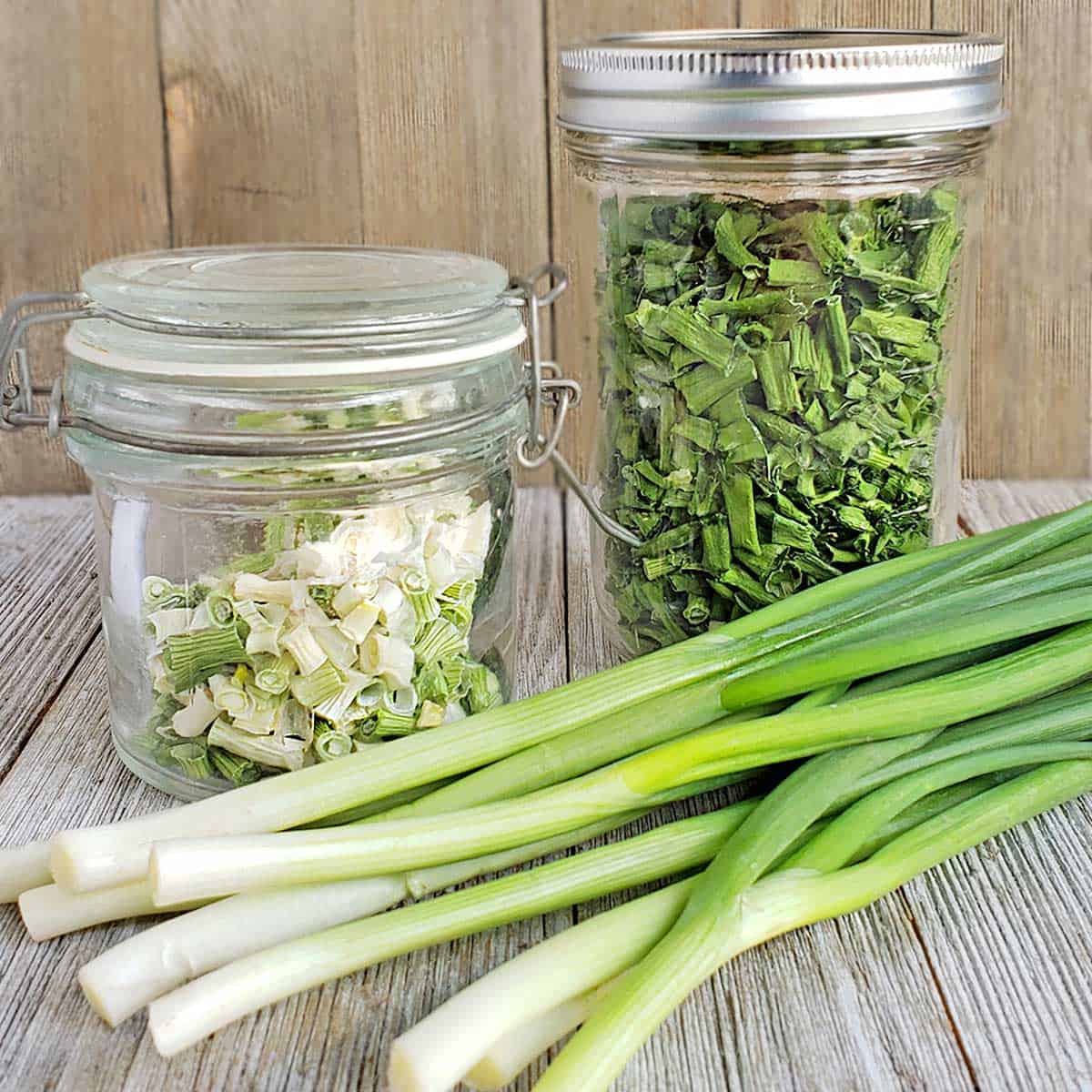
Scallions or Green Onions
Actually, they’re both. They are a member of the allium family, with a similar pungent flavor as onions, though a little milder. They’re used mostly as a garnish (white bulbous portion) to punch some fresh flavor into soups, or as a garnish (the green tops) on rice, salads, potatoes, etc., similar to how chives are used.
Because they are so inexpensive and are so easy to grow (and regrow), you might think that scallions aren’t worth dehydrating. But having home dehydrated green onion stalks is infinitely better than the store-bought version you get at the store that is lifeless and tasteless.
While most grocers only sell dried chives on the spice aisle, dried scallions can extend the flavor range of your home spice selection. Chives are cute, but they don’t hold the same flavor punch.
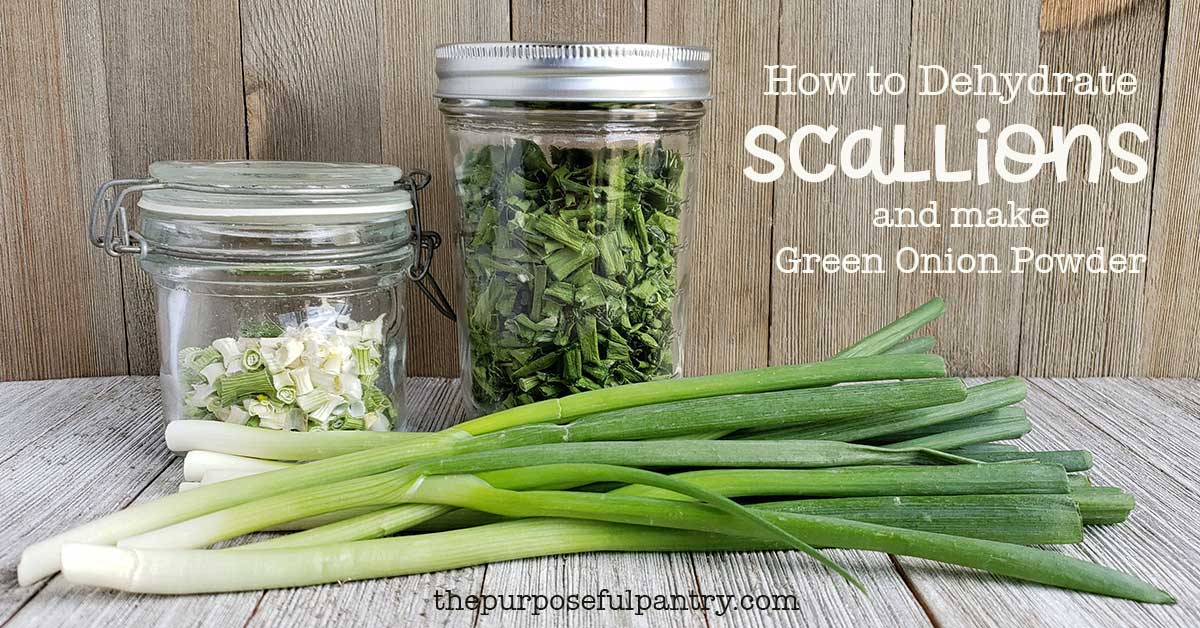
How to Dehydrate Green Onions
Quick Dehydrating Instructions
Dehydrate Green Onions at 125°F / 52°C for 3-5 hours. But read further on why I do it differently!
Directions
1. Cut off root ends.
Cutting off the root end before washing helps save you time and water to not clean something you are going to replant or compost later.
If you leave a bit more of the white bulb with a bit of the green leaves showing, you can actually re-grow these in your kitchen garden.
2. Wash and strip
You want to remove any debris that may be hanging out within the leaves, plus strip off the outer layer if it is already coming off.
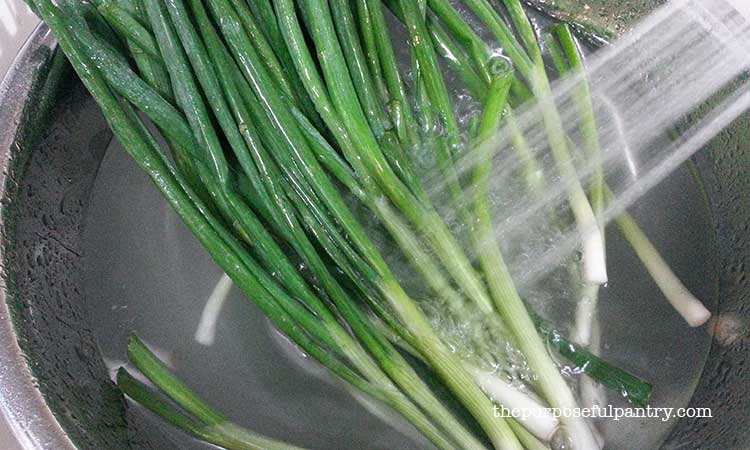
3. Chop into small, uniform pieces.
You want uniformity to ensure equal dehydration. I also choose to separate the onion at its natural separation point between the stem and the leaves.
The white bulbous portion of the scallion has a more pungent flavor than the milder leaves, so we store it differently.
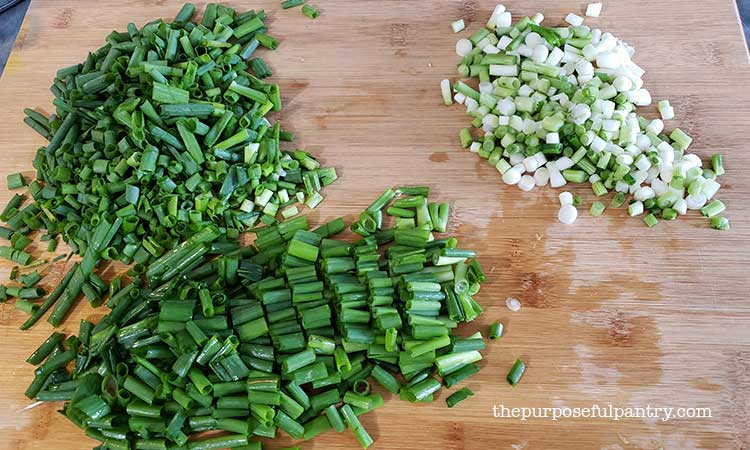
4. Separate white rings (optional).
Because the white portions of the scallion are denser but can be separated, separating them will allow all of your green onions to dehydrate at a similar pace. Leaving the white portions whole, will cause them to take longer to dry.
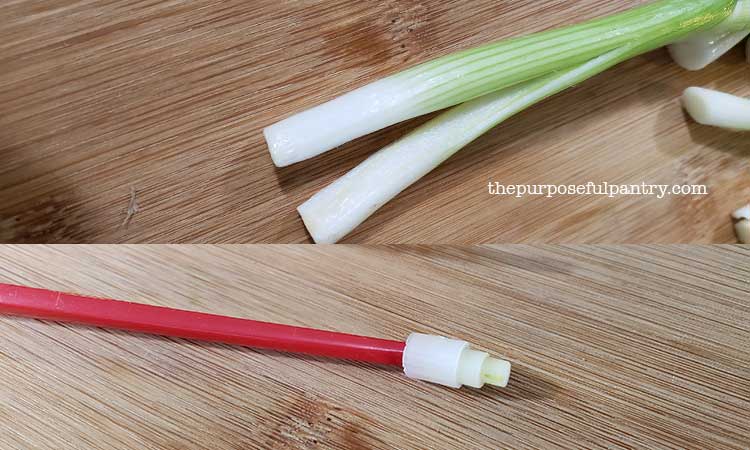
One option is to split the bulbous portion of your scallion. Another option is to use something to poke through and separate the layers (this is a reusable chopstick in the photo).
Again, this isn’t necessary but can be helpful in dehydrating time.
5. Dry on dehydrator trays for 6-8 hrs at 95°F/35°C.
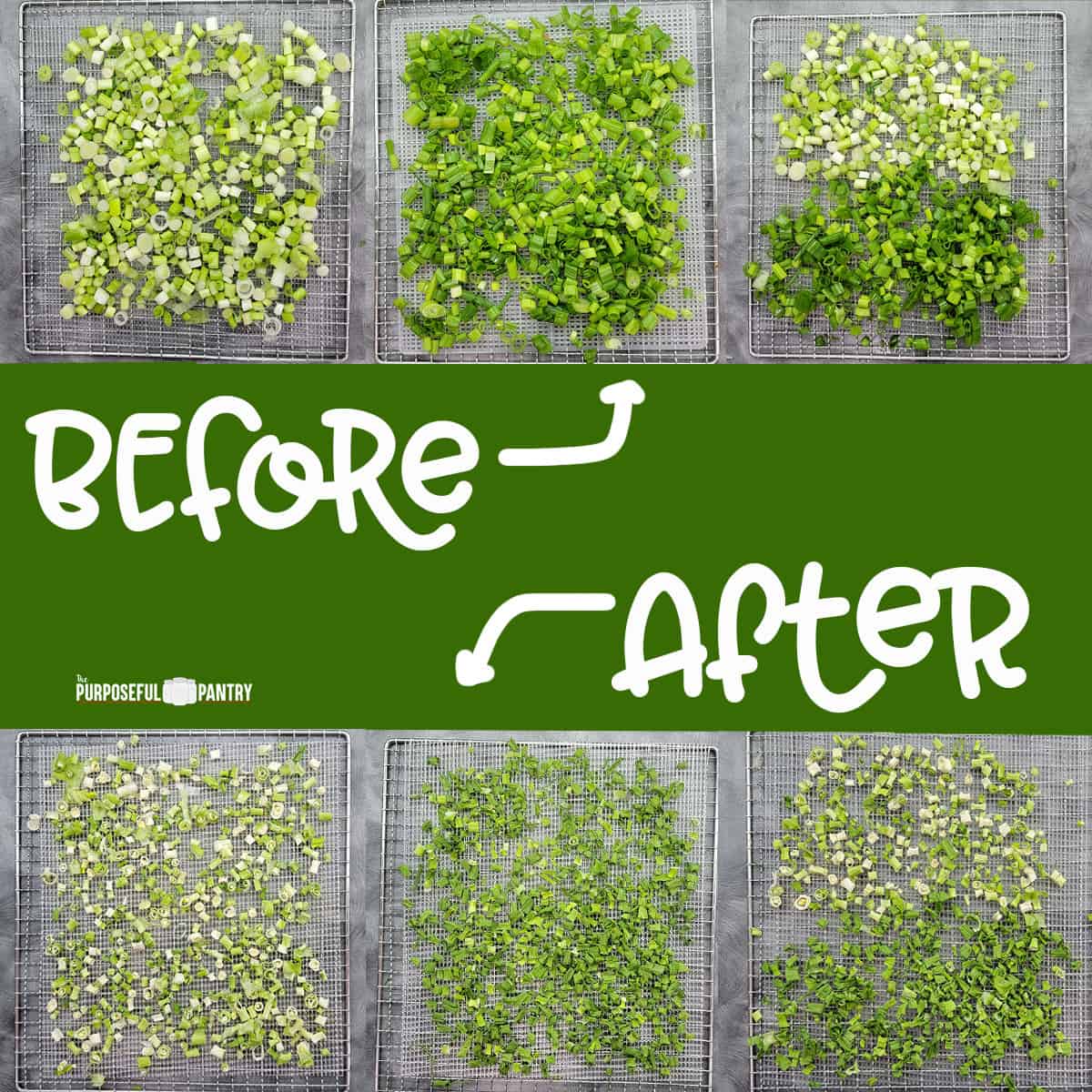
*Books and charts list scallions at 125°F/52°C as a vegetable. I prefer to dry them a little slower and keep more of the nutritional value and color.
6. Cool and Test
It is important to allow samples of your produce to cool before testing. Green onions should be dry, brittle, and easily break a part in your hand. The white ends should have no moisture on the inner most portion.
7. Condition
Place in a larger container, and shake once or twice for 5-7 days. If you see items sticking to the jar that don’t easily shake off or clump together, put produce back in the dehydrator to dry.
LEARN MORE: The reason why conditioning is so important for dehydrating!
8. Store
Store in an airtight container for up to a year or more.
Oven Directions:
- Prepare per the above directions.
- Spread your green onions onto a parchment paper-lined cooling rack if possible (I use this one from Amazon). This helps keep the greens from being in direct contact with a solid hot surface
- Place cooling rack directly into the oven, or place on to a cookie sheet. I prefer the cookie sheet method as it give me more stability in the oven to move the tray around.
- Turn oven to the lowest temperature possible. Many ovens now have dehydrating features, so set it at 125F/52C. But if your oven doesn’t go that low, set it at 170F/76C.
- Prop the door open with a heat-proof utensil – a wooden spoon, silicone spatula, silicone hot pad, etc. Please be mindful of any person who is mobility-impaired or small children while you are drying
- Dry for 3 or 4 hours, checking often so as not to burn the green onions. It may take longer, depending on the oven.
- Remove to cool and test
- Condition
- Store
Condition
- Place dried food into a jar to allow movement. Do not add moisture absorbers or any other desiccant.
- Shake once a day for 5-7 days.
- Look for signs of sticking, clumping, or moisture buildup.
- If you have clumping or sticking to the side of a jar, if it is removed with a gentle shake, it is fine.
- If it takes significant shaking to remove it or break it up, place back into the dehydrator to dry more.
- If you see mold of any kind, throw food away and sanitize the jar.
- Look for signs of sticking, clumping, or moisture buildup.
- Once complete, store in an airtight container in a dark, cool, dry place if possible.
How to Rehydrate Dried Green Onions
Place dried scallion pieces into a bowl with boiling water to allow them to steep and rehydrate.
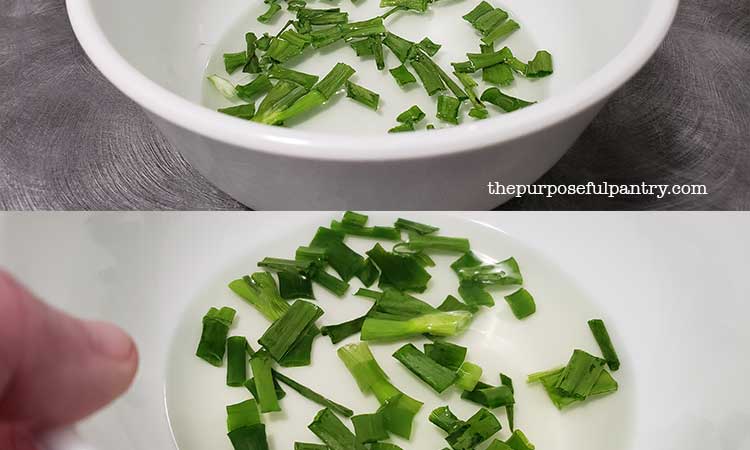
Don’t forget – use that broth! You can see it’s turning green from the nutrients and chlorophyll of the scallions – so use that broth to put into whatever dish you’re creating! If it’s not a wet dish, you can freeze the broth in ice cube trays to use when you are making broth, other soups, into rice, etc.
Take it one step further…
You know that you can’t read a dehydrating post from me and not get a portion about taking it to the next level – by using vegetable powders – right?
You can make onion powder from scallions! It may be a little different in color with the addition of the chlorophyll, but it makes an interesting twist to traditional onion powder. I can’t tell you how much I love using dehydrated powders. Now…
How to Make Green Onion Powder
Toss in the white portion of your scallions and pulse into a powder. This method works best for small portions in a coffee grinder, but any blender will do. Blenders work best when at least half full, so if you’re doing small amounts, a coffee grinder is preferable.
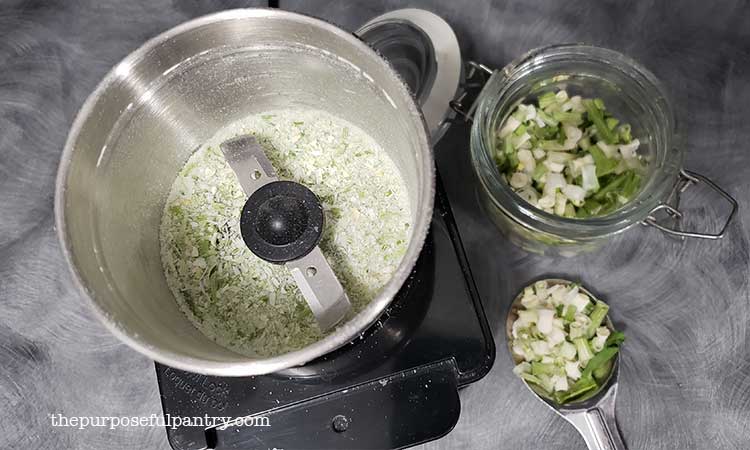
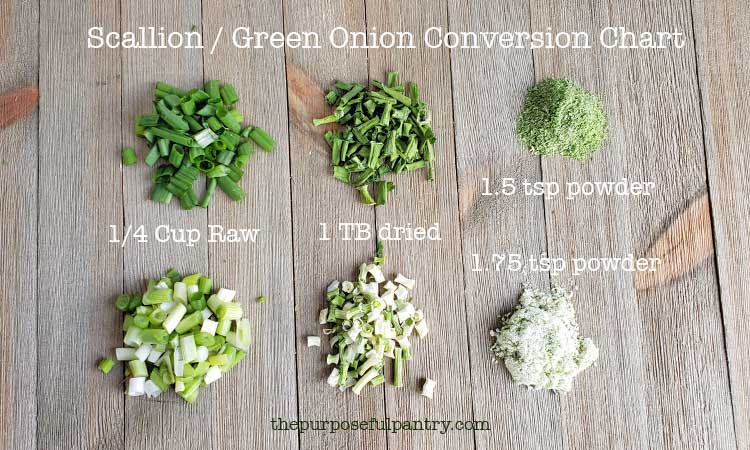
The difference between the bulbous end of the scallion and the green stems is the fiber content of the bulbous end. With more fiber and bulk, it produced more powder. You can easily combine all of these for a different flavor, too. I just separated them so that you could see the differences.
How to Use Dried Scallions
Our favorite way to use dehydrated scallions is in ramen bowls and soups. It adds a kick of onion flavor without a chunk of onion. My son loves making ramen (both store-bought and homemade), so he goes through it.
You can easily add this powder into your green powder or vegetable powder to add a little kick, or use it as a replacement for onion powder. I hope you’ll try it soon! This is definitely an easy beginner dehydrating project to try!
How to Store Green Onion Powder
You should always store your scallion powder in an airtight container. The last thing you want is your powder getting damp, losing its nutritional value or usability, so learn how to keep your powders dry!
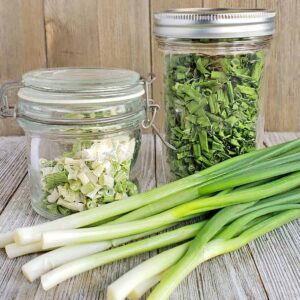
Dehydrate Green Onions
Equipment
- Cutting Board
- Airtight storage container
Ingredients
Instructions
- Cut off root ends.
- Wash and strip off the outter layer if necessary
- Chop into small, uniform pieces
- Separate white rings if desired
- Dry for 6-8 hrs (your hours may vary)
- Cool and Test
- Condition
- Store in airtight containers
Video
Darcy’s Tips
Oven Directions:
- Prepare per the above directions
- Spread your green onions onto a parchment paper-lined cooling rack if possible (I use this one from Amazon). This helps keep the greens from being in direct contact with a solid hot surface
- Place cooling rack directly into the oven, or place on to a cookie sheet. I prefer the cookie sheet method as it give me more stability in the oven to move the tray around.
- Turn oven to the lowest temperature possible. Many ovens now have dehydrating features, so set it at 125F/52C. But if your oven doesn’t go that low, set it at 170F/76C.
- Prop the door open with a heat-proof utensil – a wooden spoon, silicone spatula, silicone hot pad, etc. Please be mindful of any person who is mobility-impaired or small children while you are drying
- Dry for 3 or 4 hours, checking often so as not to burn the green onions. It may take longer, depending on the oven.
- Remove to cool and test
- Condition
- Store
Nutrition
Nutritional information is an estimation only. Nutrient information for dehydrated foods is based on fresh. Use 1/4 of the servicing size for the same nutrient information. Thus 1 Cup of fresh fruit has the same sugars as 1/4 dried.
©ThePurposefulPantry. Photographs and content are copyright protected. Sharing of this recipe’s link is both encouraged and appreciated. Copying and/or pasting full recipes to any social media is strictly prohibited.



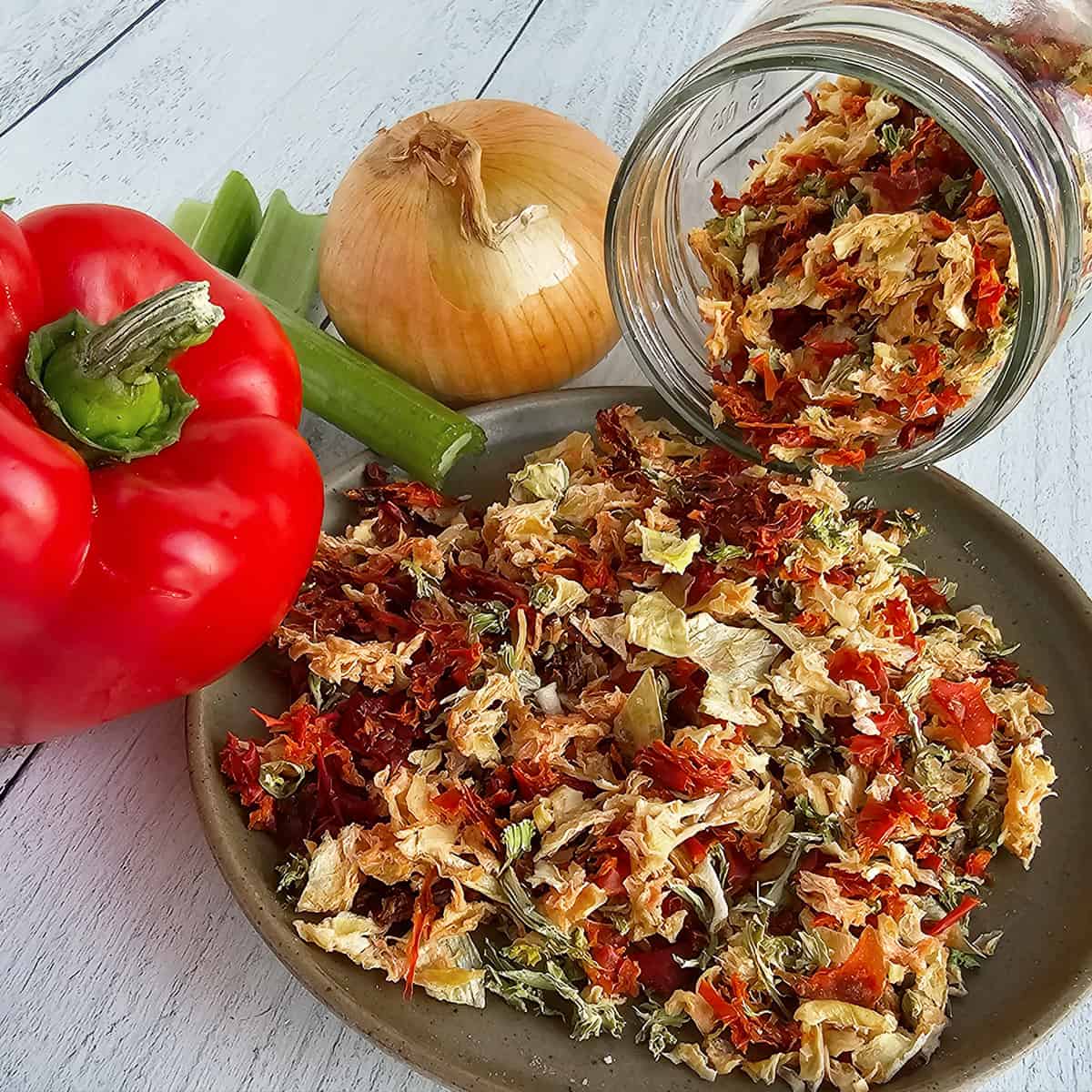
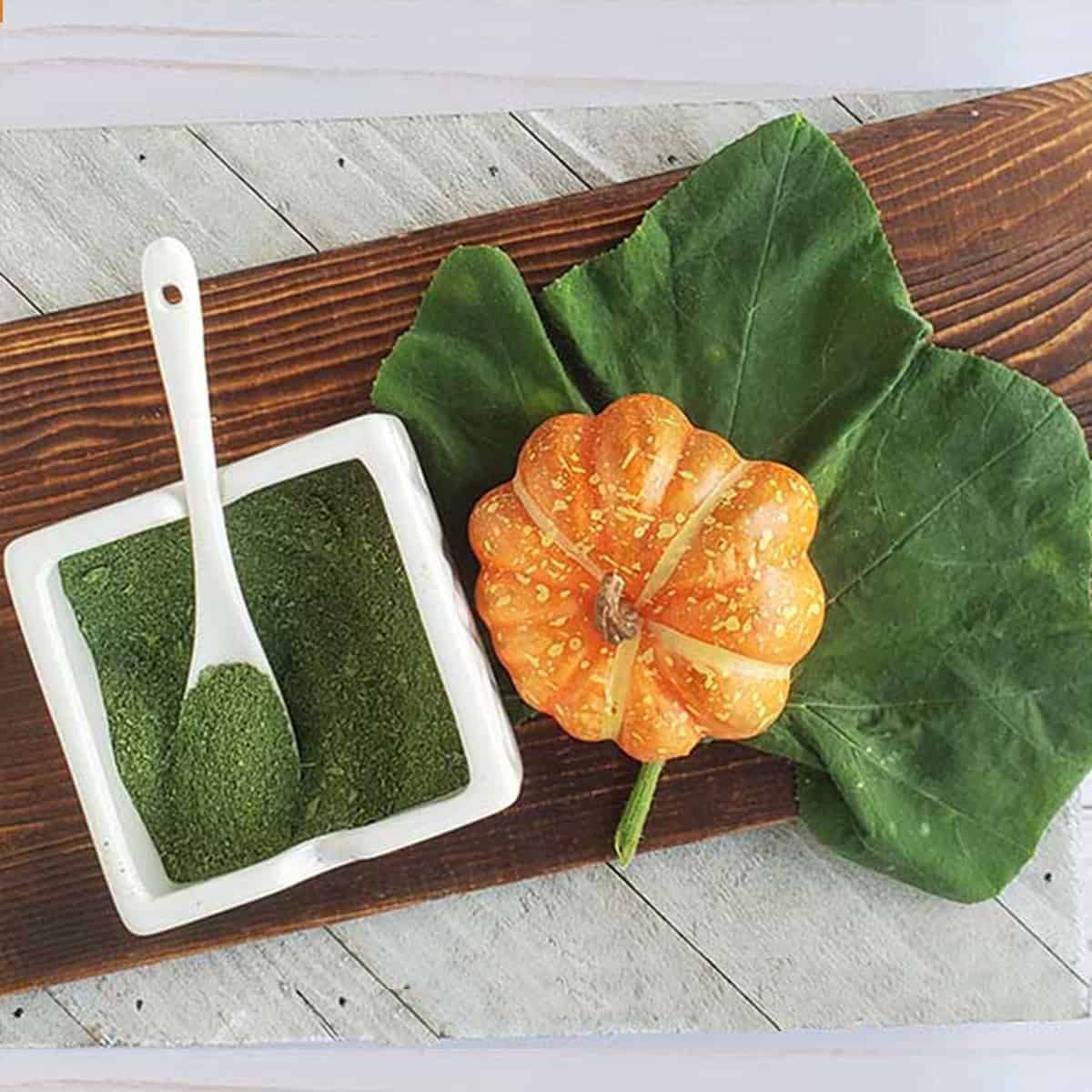
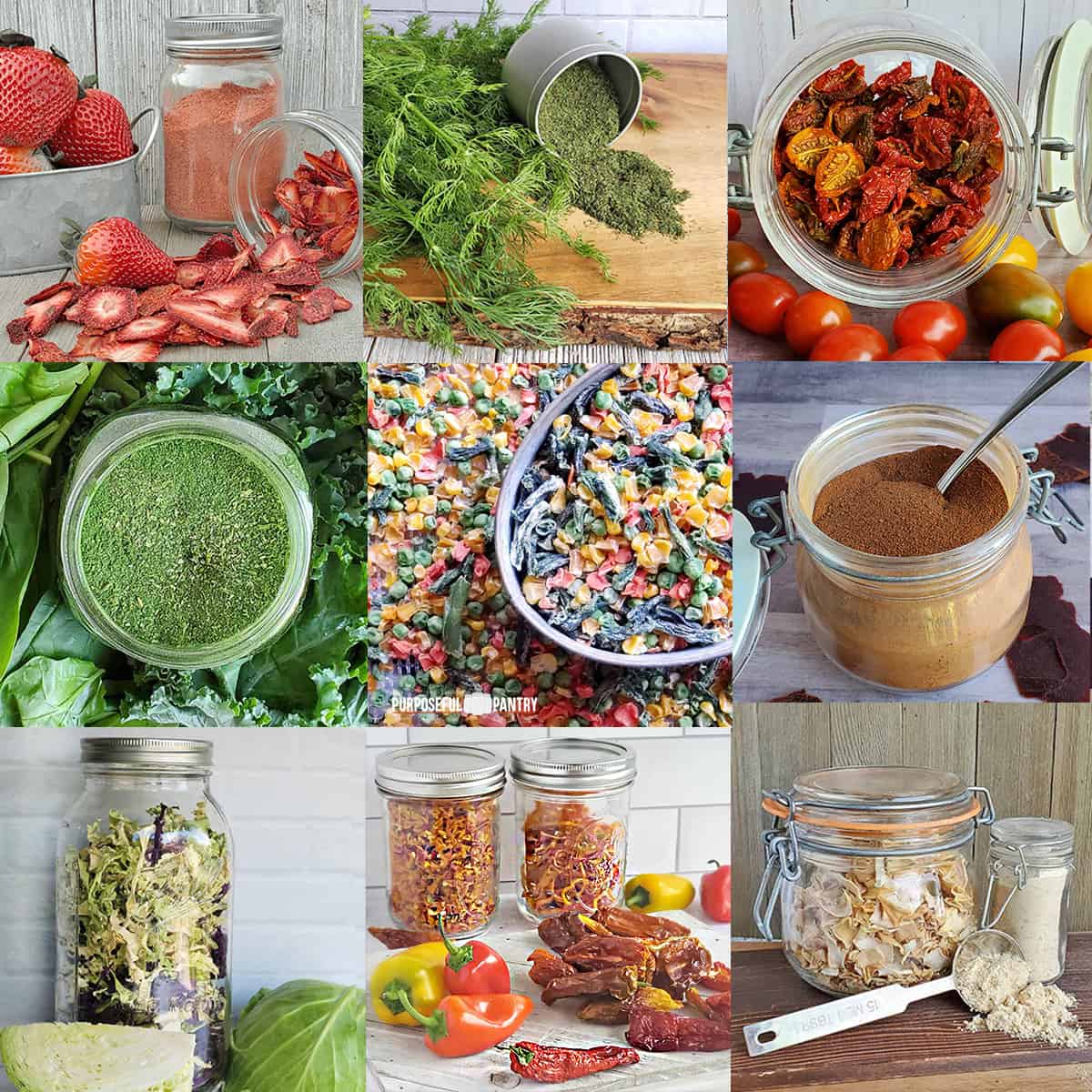
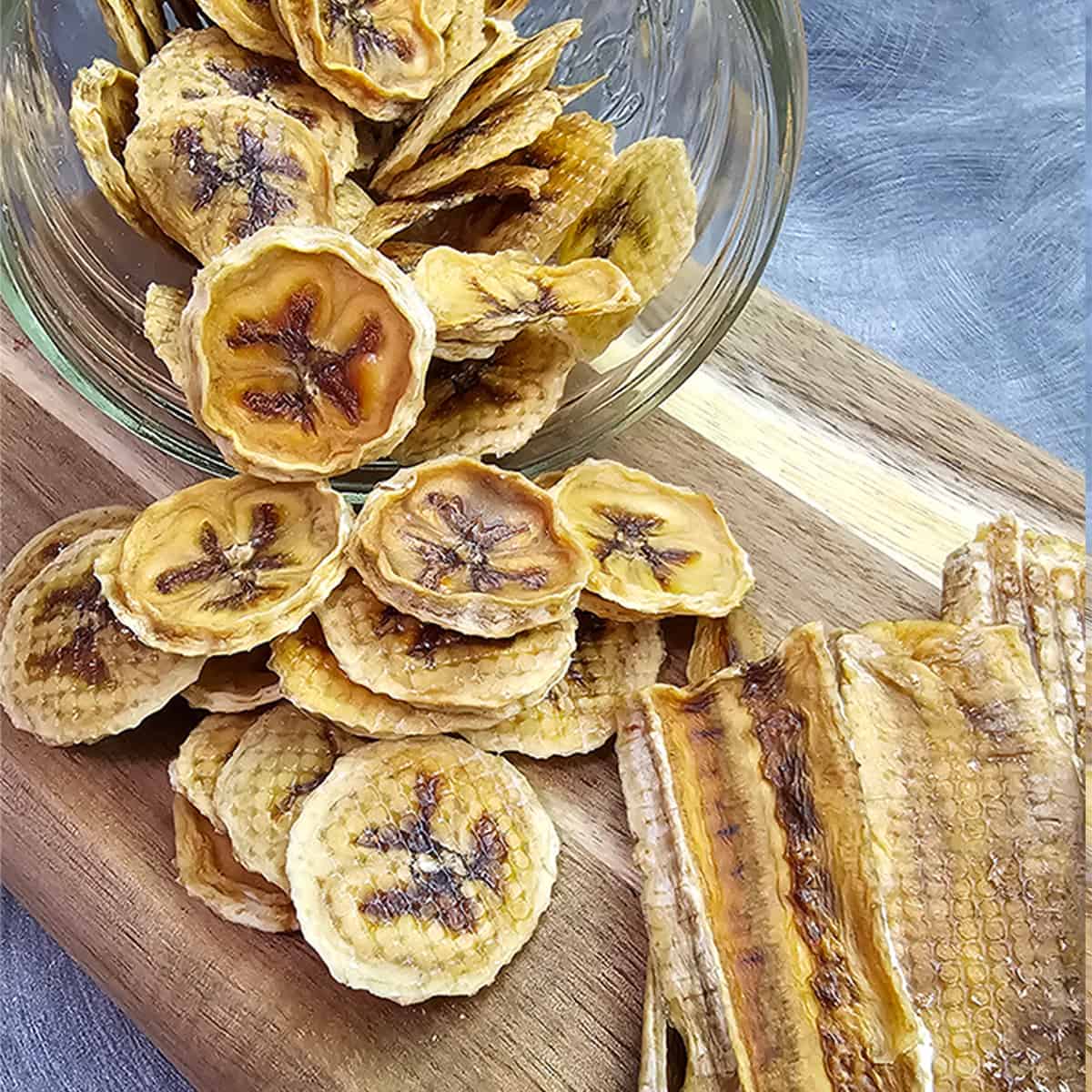
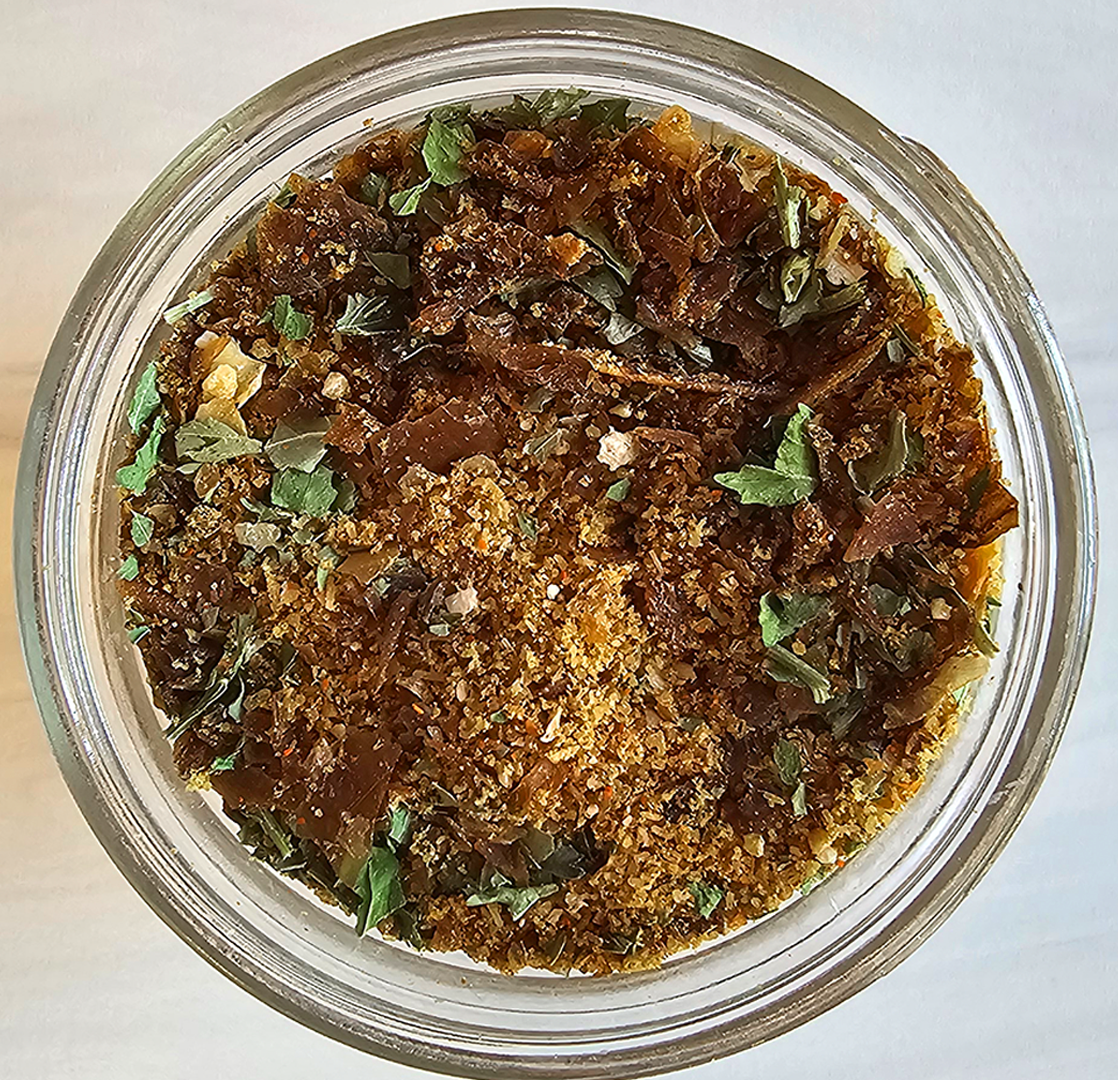
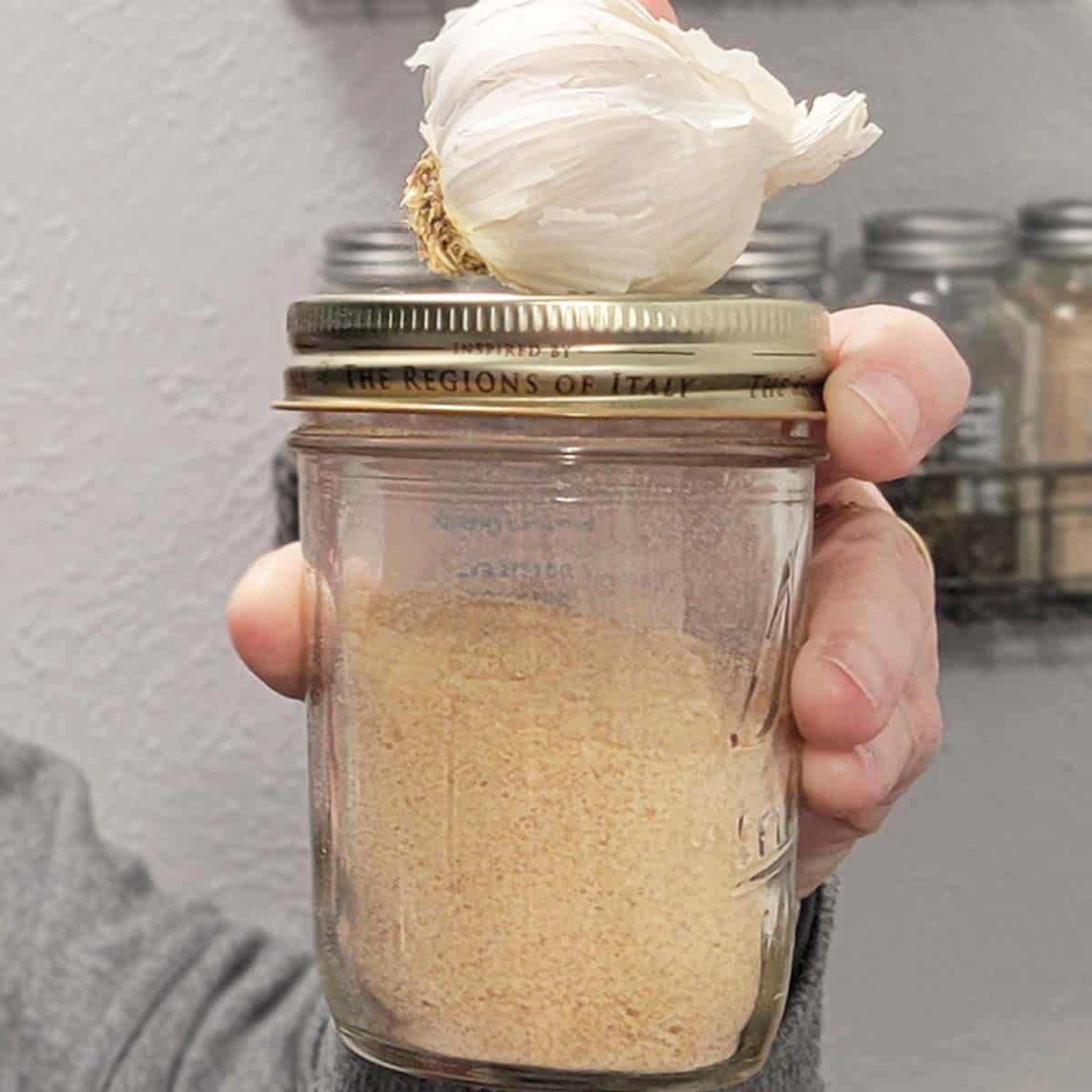
This worked very well for me. My neighbor shared his huge crop of green onions with me and now I am set for at lest a year. I have used them in chicken salad and my husband brags on how good it is.
We do that, too!
Can you put dehydrated green onions on salads after you re-hydrate them? Will they still have a crunch?
No food comes back to fresh once rehydrated, so no, they will not be crunchy, but we use them all the time.
Since I now live in the high desert of New Mexico and not in humid Florida anymore, I find it easy to simply dry herbs, mushrooms, green onions, garlic scapes, chile peppers, etc. in brown paper bags that are exposed to air on all sides. Has not failed me yet.
I also agree about making powders. I save parsley and cilantro stems, and Thai basil stems to dry then grind. Mushroom and chile powder is also easy to make. If I don’t use up fresh herbs or I know I won’t be able to get to them, I have ongoing bags at-the-ready for parsley, basil, cilantro, shiso, lemon balm, celery leaves, and more for drying. They keep well in this arid environment until they’re ready to grind.
I don’t like waste so drying is the way to go, whatever method one chooses to use.
Thanks and Happy Drying!
Hi Darcy,
Can I dehydrate green onions that I’ve had in the refrigerator?. Thanks!
Of course, you can – no difference in the process just because they are refrigerated.
Regarding your suggestion, “Cutting off the root end before washing helps save you time and water to not clean something you are going to replant or compost later.”
It’s important to wash the produce before cutting so you don’t risk contaminating the interior with the bacteria from the exterior. If you cut into a dirty fruit or veg, the dirt is on the knife and carries through the food. You risk salmonella and other contaminents.
You are correct, Lisa. And the comes from my natural tendency to strip the onion first, then cut into the fresh flesh not the outside, which then isn’t an issue, but I’ll be more clear in my comment.
I never waste the white end. it either gets chopped or planted.
I have a lovely crop from supermarket leftovers, too
I have dehydrated bulbing onions in the past but didn’t think it would work for green onions! Thanks for the tips! Love the idea of making onion salt from these!
Works great! And the powder is a nice little change from regular onion powder!
Hi Darcy,
I have dehydrated onions but not the green onions…great idea! I have some seedlings started under lights for my garden this spring. 🙂 Thanks for sharing!
Hopefully you’ll have some dried storage soon after 😉
We dehydrate onions all the time. We do them outside because of the aroma can get intense. We always do potatoes next to help get rid of the onion odor
These are pretty pungent the first hour or so, but then aren’t too bad – not like full onions. We don’t dehydrate outside because of the humidity levels.